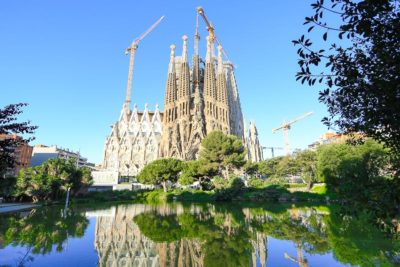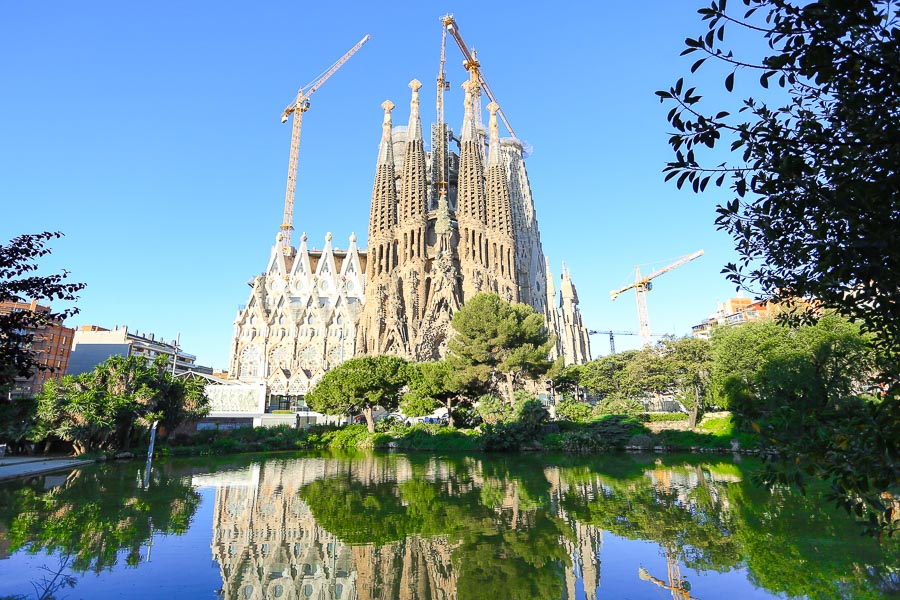
Hitting up La Sagrada Familia for the first time?
You’re at the right place!
La Sagrada Familia Basilica is a must-see in Barcelona, facing a namesake square in the heart of the city.
Dubbed as the world’s only unfinished World Heritage site, La Sagrada Familia is one of the last works by a talented and somewhat crazy architect Gaudí, starting in 1882 yet only 70% of the project has terminated.
Today, La Sagrada Familia remains a vivid symbol, blending traditional Gothic and modern Art Nouveau styles with four towering spires and three mesmerizing facades that provide entry to the top.
Check out this comprehensive guide to La Sagrada Familia to select the best tickets and entry time, as well as discover things to see.

Read More: Our 15 Favorite Things to do in Barcelona: Cathedrals, Photo-Ops, Timeless Works of Arts and More
La Sagrada Familia Tickets: Choose The Best Option
There are four ticket options to choose from, each of which comes with either an audio guide or a specialized guide. And trust me, having a guide will elevate your trip to a whole new level with untold stories and secrets.
This is a standard ticket that lets you download the Sagrada Familia app to manage your tickets and access their audio guide.
With a few pennies more, you’ll have a chance to follow one of their licensed guides who go above and beyond to explain what went into conceptualizing and designing the building,
Here’s a breakdown of the pricing list:
- Sagrada Família: EUR 26
- Sagrada Família With Guided Tour: EUR 30
- Sagrada Família With Guided Tour And Towers: EUR 40
If your fitness level agrees, choose this package to access their two towers by following the tour guide’s steps. The best-kept secrets will be unveiled and you’re guaranteed some of the best scenic vistas over Barcelona from the top of the world.
Remember that access to only one tower at a time (between the “Nativity Facade” and “Passion Facade” sides) is allowed so choose accordingly. Be punctual as the staff won’t accommodate climbing at other times. Kids under six years old can’t climb the tower.
After the purchase, you’ll receive access to the app to manage your tickets and audio guides. Scan QR codes at the entry to enter.

I highly recommend you buy tickets online – either directly on the website or through a third-party operator for potential discounts. Get rid of unnecessary hassle from on-site queues by selecting your preferred date and time in advance.
The best time to visit La Sagrada Familia is early at 9 AM when it’s open. Alternatively, a late afternoon visit also comes in handy when the crowd thins out.
La Sagrada Familia is an amazing attraction for photography. If you plan to capture the best shots here, plan accordingly.
La Sagrada Familia Dress Code
Despite being a highly-visited attraction, La Sagrada Familia remains a holy shrine and a national symbol. For that reason, avoid sleeveless tops, shorts, and short skirts. Ensure your clothing covers shoulders and extends below the knees. Swimwear, see-through outfits, and festival-related attire are not permitted.
The Exterior of Sagrada Familia

The awe-inspiring facade of the church captivates with a series of exquisite carving details that depict the life of Jesus Christ – crowned with a monumental cross.

Capping off the top, the four smaller spires jut out to the sky, depicting traditional Evangelist symbols that include a bull (Saint Luke), a winged man (Saint Matthew), an eagle (Saint John), and a lion (Saint Mark).



Though left unfinished, the exterior of the church still captivates with an amazing feeling when each object, statue, and symbol is crafted with so much love and effort.


Sagrada Familia Towers

Speaking of the towers, you’re referring to the two facades of the church:
The Nativity Façade (54.8 meters): is the entrance’s highlight and the oldest one out of the two. It was the only facade crafted by Gaudí himself, displaying intricate carvings portraying biblical stories, emphasizing the conception of the Virgin Mary and the growth of Jesus.


The Nativity facade faces east and is centered around the birth of Jesus, taking 36 years to complete.


Before entering, step back to appreciate the copper door decorations reflecting Gaudi’s attention to different flora and fauna species such as green leaves and insects.

This is one of the most exceptional features that promote Gaudi’s intentional love for nature.

Even the pillars at the door’s base are supported by turtles, with one pair symbolizing the earth and the other representing the ocean.

The Passion Façade (74.9 meters): faces west, sparkling a stark contrast to the Nativity Facade from the other side thanks to its bold, simplistic cubist style, intentionally chosen by Gaudí himself.

Right here, you’ll find colorless sculptures and bone-like columns. The majority of the concept is centered on Jesus’s death and resurrection, partly reflecting Gaudi’s experience of near death due to illness.

To emphasize Jesus’s pain and solitude, Gaudi brought up sharp angles and expressive postures that wrap around these figures.
No matter which facade you’d like to enter, each tower promises breathtaking views of Barcelona, spanning from iconic Park Guell to the Mediterranean Sea. Capture the scenery in photos and relish the feeling of being on top of the world.
Descent is only accessible via stairs so keep that in mind if you visit La Sagrada Familia with children under six years old or seniors with mobility issues.
The Interior of La Sagrada Familia
As Gaudi once said: “Straight lines belong to humans, curves belong to God” – La Sagrada Familia intentionally exudes this philosophy, resembling a microcosm of nature with its absence of absolute straight lines.

Teaming up with bold and sharply defined curves that wrap the exterior, the main hall of the church is even more interesting to contemplate.
Right here, you’ll be stunned by 56 peculiar pillars that mimic a forest. Get up close and you shall see that each “arm” is dotted with white eyes, bringing out an enchanting and somewhat mysterious setting for the holy hall.


Another highlight that surely strikes your impression is a set of stained-glass windows. As sunlight filters through the colored glass up on the wall, it casts the space with vibrant hues, mirroring the dynamic illumination of a sunlit forest.

When the sun is out, each window transforms into a playful mashup of light and shadow.



Eventually, make your way to the museum sheltered in the basement of the church. Right here, some of Gaudi’s historical context, design concepts, and architectural structure are kept intact, offering you a deeper understanding of his original intention.



Final Words: Is La Sagrada Familia Inside Worth It?
Not only is La Sagrada Familia worth visiting but it’s also one of the most incredible cathedrals the world has ever seen.
The history, blood, sweat, and tears put into this massive religious building make it even more interesting to visit, telling a story of a project spanning almost 140 years.
Today, La Sagrada Familia remains 70 percent complete, making it one of the world’s lengthiest architectural endeavors.
Be Inspired With My Spain Travel Guides
- 11 Signature Spanish Dishes You’ve Gotta Try (& Where To Find Them)
- A 2024 Comprehensive Guide to Madrid, Spain: Top Attractions, Navigation, & Best Places To Stay
- A Comprehensive Travel Guide To Cordoba: Top Places To Visit, Food Spots, & More
- An Infinitive Travel Guide To Granada: A Heritage City Blessed With Moorish Culture
- Seville’s Attraction Guide: From A Moorish Empire To Game Of Thrones Filming Location


